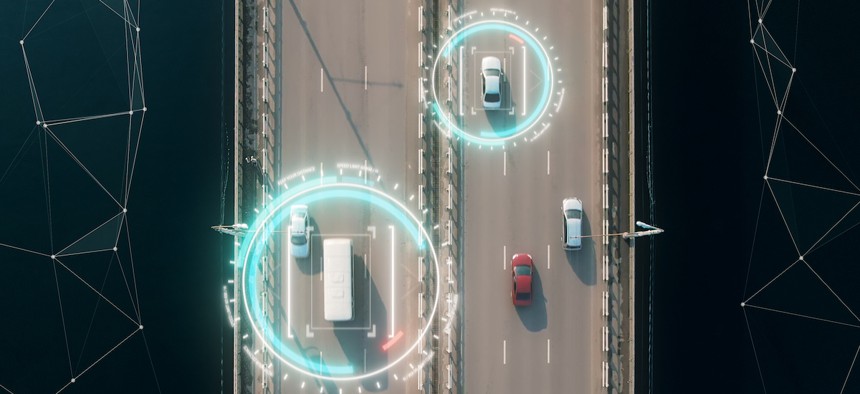Two states get waivers for connected-vehicle tech

FlashMovie/Getty Images
Intelligent transportation projects in Virginia and Utah can use cellular vehicle-to-infrastructure technology ahead of the FCC’s final adoption of C-V2X rules.
The Federal Communications Commission recently approved a waiver that will allow connected vehicle projects in Virginia and Utah to use cellular vehicle-to-infrastructure technology ahead of the FCC’s final adoption of C-V2X rules.
C-V2X technology allows vehicles, motorcycles, bicyclists and pedestrians to directly communicate over LTE or 5G with roadway infrastructure like traffic signals to improve transportation efficiency and prevent accidents. Communicating via the interference-free Safety Band at 5.9 GHz, the technology can also enable the transmission of real-time warnings to signs, electronic traffic control systems as well as vehicles equipped with onboard units.
The waiver covers roadside unit license areas, communications zones and registrations as well as available RSU frequencies, maximum power limits, antenna height, priority communications and onboard units installed in vehicles.
Fourteen organizations make up the joint-waiver participants, which include automobile manufacturers, makers of roadside unit and onboard unit equipment as well as the Virginia and Utah Departments of Transportation.
In an ex parte filing to the waiver application filed last year, the joint-waiver parties stressed the importance of granting the waiver, noting that Chinese transportation authorities were already ramping up their C-V2X efforts in both vehicles and infrastructure, with 7,000 C-V2X RSUs already having been deployed.
The waiver would allow the Utah Department of Transportation to begin widescale deployment of C-V2X smart infrastructure and permit the Virginia Department of Transportation to deploy C-V2X in construction areas and along major corridors, the filing said.
In a Feb. 13 letter to FCC Chairwoman Jessica Rosenworcel, Sens. Gary C. Peters (D-Mich.) and Cynthia M. Lummis (R-Wyo.) urged the FCC to quickly act on the waiver application, stressing the safety benefits to C-V2X technology. They cited National Highway Traffic Safety Administration estimates that “safety applications enabled by C-V2X could eliminate or mitigate the severity of more than 80 percent of light vehicle crashes.” They also noted the technology’s potential to improve roadway efficiency and reduce emissions.
In its April 24 order, the FCC said it believes the waiver will spur early C-V2X deployment and “will serve the public interest by advancing vehicular safety and promoting interoperability.”
Intelligent transportation advocates hailed the news.
“This is a significant step forward,” said National Transportation Safety Board Member Michael Graham. “V2X is one of the most promising lifesaving technologies available today, and these waivers allow state DOTs and automakers to continue development, begin deployment and, finally, begin achieving that safety promise.”
“[The] decision is a win for investing in the digital layer of transportation that enhances safety for all who travel on our nation’s roads,” Intelligent Transportation Society of America President and CEO Laura Chace said in a statement. “This is a crucial first step towards deploying lifesaving communications technology that will augment thousands of miles of hard infrastructure on our nation’s roadways, beginning immediately.”
NEXT STORY: How One City Transformed Its Approach to Data






